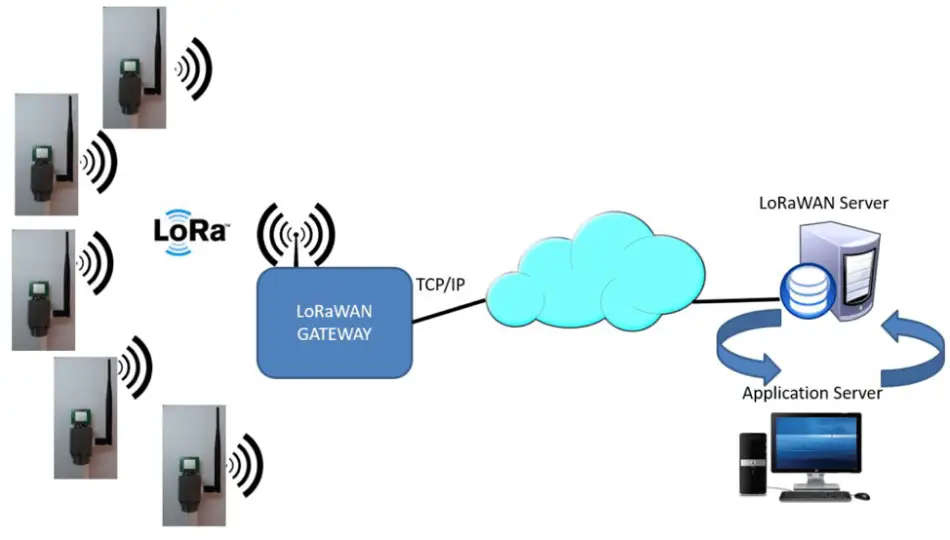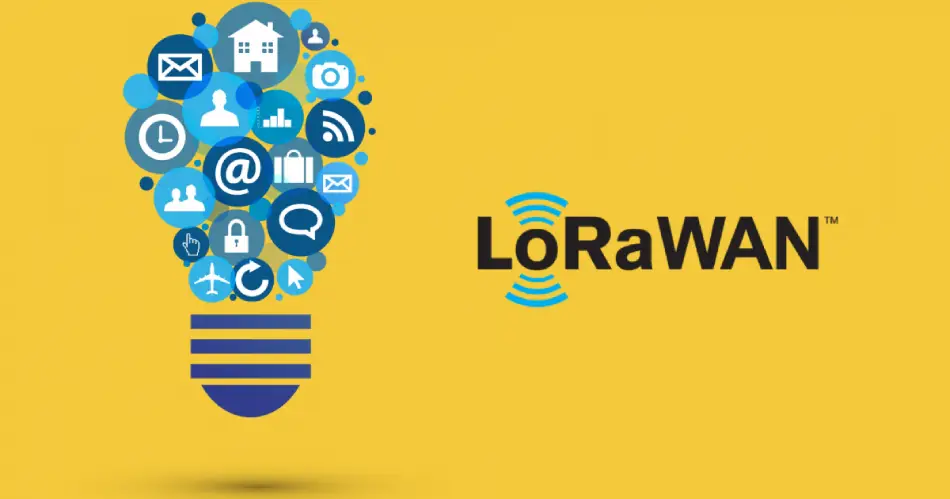What is LoRa and LoRaWAN?
LoRa is a new communication standard for the Internet of Things, which is commonly used for small signal data transmission over very long distances. LoRa sensors typically have low power, low power consumption, and long battery life. LoRa is the abbreviation of the word “Long Range”. From the name, it can be seen that the main feature of LoRa is the long transmission distance. LoRa’s signal modulation scheme, developed by Semtech, enables excellent link margin. LoRa’s signal sensitivity is very high, so LoRa can maintain long-distance communication, even in noisy environments. Similar to other LPAWAN technologies such as NB-IoT, LoRa typically operates at lower data rates, which further increases link headroom. Due to its low data rate, LoRa is not suitable for scenarios that require high data delay.
LoRaWAN is a communication standard of LPWAN protocol based on LoRa chip, which is designed for remote IoT connection. LoRaWAN was originally called LoRaMAC, which is a set of communication protocols and system architecture based on LoRa long-distance communication network design. According to the traditional communication protocol, LoRaWAN is the MAC layer, and LoRa is the physical layer. LoRaWAN is an open network standard, and its data link layer access control (MAC) is maintained by the LoRa Alliance.
What are LoRaWAN gateways and LoRaWAN cloud servers
The LoRaWAN gateway is a LoRa network connector, which can convert the LoRa network communication protocol to the TCP/IP protocol, and transmit the data of the LoRaWAN device to the network. This is similar to setting up an industrial wireless router to connect WiFi devices to the network. Gateways are usually deployed by users or solution providers and are usually deployed at remote regional centers without other types of coverage.
The LoRaWAN cloud server is a cloud service center that manages device connections and communications. The web server can be a physical server or a cloud server. When the web server is in the cloud like the hosting service, the gateway operates in a so-called “packet forwarding” mode, which just passes all the original LoRa data packets in the air to the web server and the web server. In this mode, all information such as data encryption and packet decryption, device management and connection, data analysis and processing are stored in the ECS, which makes it easier to manage and upgrade the server and easier to read and process data.
How does LoRaWAN work
In terms of network structure, LoRaWAN’s wireless protocol is very simple. Its network structure is a star topology, which is conducive to LoRaWAN terminal equipment to increase communication range and reduce power consumption. After demonstration and test, this star structure is more suitable for this kind of Internet of things application scenario with low power consumption and large area than the grid structure.
The network layout of the star topology is the central data processing mode. Each LoRaWAN terminal device transmits the data to multiple LoRaWAN gateways, and then the LoRaWAN gateway transmits the data to the central server. The central server centrally manages and processes the collected data, and the server will complete the message scheduling, security investigation, and redundancy detection of the data. The central server feeds back some information of LoRaWAN terminal equipment according to the data so that LoRaWAN can make a certain response.
Two obvious advantages of LoRaWAN protocol
- More convenient tracking: the gateways do not need to communicate with each other. The information of the terminal node is broadcast. The signal of a terminal node can be received by multiple gateways. The direction and position of the terminal node can be roughly determined according to the time difference between the information received by the gateway. This logic and algorithm are relatively simple.
- Simpler information link: the gateway is only used as a bridge to realize the information transmission between the node terminal and the server. There is no mutual communication between the gateway and the gateway, and the information link is fresh and simple.
LoRaWAN devices types: Class A, Class B and Class C
Class A is an asynchronous operation. The characteristic of the asynchronous operation is that it does not need to queue like a synchronous operation. When the terminal node needs to transmit data, it will connect with the gateway, rather than waiting for a specific time or queuing for the completion of thread tasks. The terminal node is in a sleep state before transmitting data. After the node completes the transmission, it will immediately enter the sleep state. When one node completes transmission, the other can start transmission immediately. There is no gap in communication. Since class A is asynchronous transmission, collision is inevitable. The theoretical maximum capacity of a pure Aloha network is about 18.4% of the maximum. If two nodes wake up at the same time and decide to transmit on the same channel using the same radio settings, they will collide and collide.
Class B allows information to be sent to the terminal node. LoRaWAN gateway sends a beacon every 128 seconds. All LoRaWAN base stations also send beacon messages. Their internal clocks are synchronous and belong to one pulse per second (1PPS). The synchronization satellite in orbit will transmit a message at the beginning of each second, which can synchronize the time around the world. Lora Wan base station also depends on this synchronization time. Every beacon sent by the gateway allocates a time gap of 128 seconds to tell the node when to receive the signal.
Class C allows the node to keep listening for a long time without sleeping and can send downlink messages at any time. Class C is in the wake-up state for a long time and needs to consume energy to maintain the wake-up state of the node to monitor the received signal in real-time. All class C consumes a lot of energy and is not suitable for battery power supply. It is mainly used in scenarios where the power supply can be stable.
Why use LoRaWAN instead of WiFi, Bluetooth, Zigbee, and more
LoRaWAN has its own application scenarios with WiFi, Bluetooth, ZigBee, mobile phones, etc. in long-distance transmission, LoRaWAN has obvious advantages over the others. WiFi, ZigBee and Bluetooth use a 2.4GHz spectrum. The advantage of this spectrum is that it can carry a large amount of information and fast speed, but it is not a good choice for wireless sensors.
- The 2.4GHz spectrum weakens rapidly in the air. The network sensor of this communication protocol usually has a very short connection range, and the physical penetration of the 2.4GHz spectrum is very poor. Most signals can not penetrate other roadblocks such as building walls. In daily life, in the corner or closed area such as basement or toilet, the WiFi signal in the hall will be very weak or basically absent. Home automation systems that use protocols such as Zigbee often find that they cannot connect to the next room. On the other hand, LoRa equipment can reach distances of several miles in an open-air environment and can perform well through obstacles such as buildings or equipment.
- the 2.4GHz spectrum is very “noisy”, which means that there are 2.4GHz devices around us competing for broadcast time, which affects the quality of the link. The operating frequency of LoRa in the United States is 915MHz, so it will not interfere with local WiFi and most other wireless devices.
- WiFi, a network communication protocol, is very poor in key management and network security prevention and control, and it is very inconvenient to use on many occasions. For example, if a WiFi router connected to multiple devices wants to change the connection password, you need to change the connection password of all connected WiFi terminal devices. However, if the WiFi terminal device is a small battery-powered electronic device that does not meet the user, it is difficult to connect to the WiFi server that has changed the password. In life, WiFi is generally used on smartphones, smart TVs, laptops and other devices. These devices have display screens and libraries to easily change passwords. But reconnecting the WiFi router is very difficult for simple battery-powered sensors.. On the other hand, LoRaWAN configures and protects equipment in different ways. The key is not a single password defined on the web server, but is derived from the sensor itself and has a unique value that can be supplied on the webserver (usually in the cloud). All radio bridge sensors have a unique ID/key pair, enabling efficient security configuration and management.
- The battery consumption of terminal devices such as WiFi, Bluetooth, ZigBee and mobile cellular devices is relatively high. These devices send a large amount of signal information, and the spectrum weakens quickly, and the transmitted power is relatively high, so as to ensure a certain coverage. These devices must maintain regular communication with the gateway or base station in order to maintain the connection state. On the other hand, LoRaWAN devices can enter a deep sleep mode and wake up only when necessary to send to deliver new events. In most applications, this allows battery life to be as long as 5 to 10 years.
LoRa is a radio modulation technology used for wireless LAN networks in the LPWA network technology category. LoRaWAN is a network (protocol) that uses LoRa.
Look into the future of LoRaWAN
Low power Internet of things is more widely used in smart city construction. With the deepening of smart city construction, urban perception applications will be paid more and more attention. This kind of Internet of things application has its special points: huge connection, low communication frequency, low power consumption, complex coverage environment and high-cost sensitivity. Therefore, low-power Internet of things is more suitable for urban perception Internet of things application system.
Why does LoRa technology attract the attention of the industry? LoRa technology has a wide application prospect in many fields with excellent performance and flexible networking form. In addition, the implementation architecture of LoRa long-distance transmission, the three behavior modes of LoRaWAN, and the typical architecture and application of LoRa. In addition to the smoke monitoring systems, power environment monitoring systems, air conditioning energy-saving monitoring systems and intelligent care monitoring systems, the popularization of the Internet of things should be based on people-oriented. Life safety, transportation and medical treatment, environmental pollution, food problems and human resources are all vertical application fields of the Internet of things that have been widely concerned for a long time, LoRa has more advantages than other communication technologies in these scenarios.
The era of interconnection of all things is also the era of data as the king. However, in many cases, if intelligent objects do not have corresponding location information, it means that the data is “chaotic” and the available value will be greatly reduced. With the vigorous development of the Internet of things industry in the past two years, the demand for positioning technology in various Internet of things application scenarios has also greatly increased. At present, there are dozens or even hundreds of types of positioning technology, and each positioning technology has its own advantages and disadvantages and suitable application scenarios.
LoRa is applicable to local areas with higher density and has the characteristics of relatively independent, stronger signal and lower cost. Therefore, LoRa must have a place in the future broad blue ocean market of the Internet of things. As for the future development prospect of LoRa, it still depends on the joint promotion of people in the industry.
















